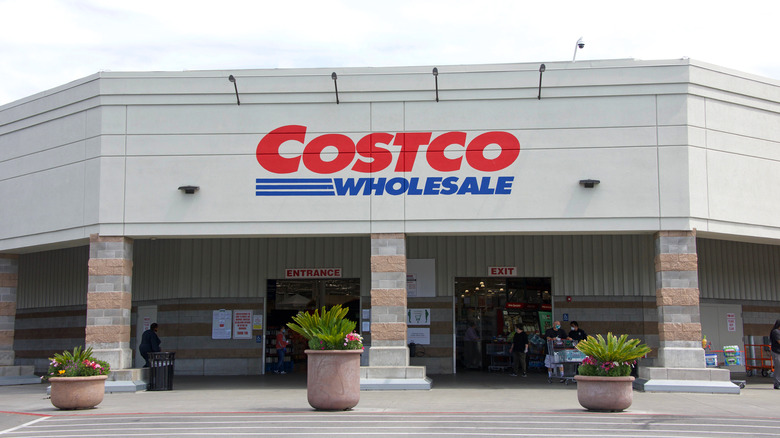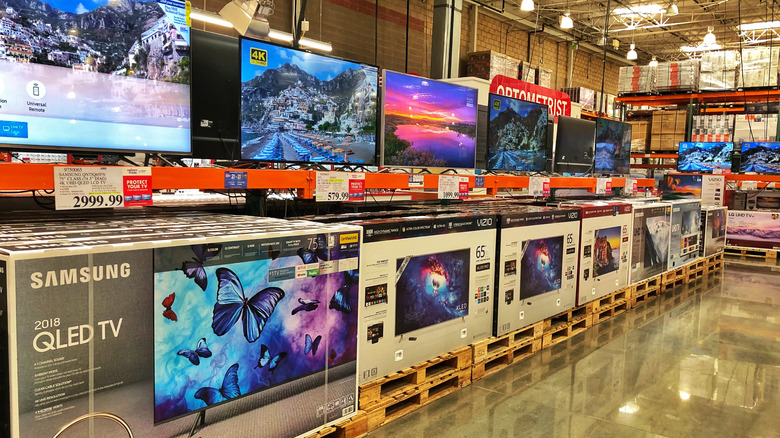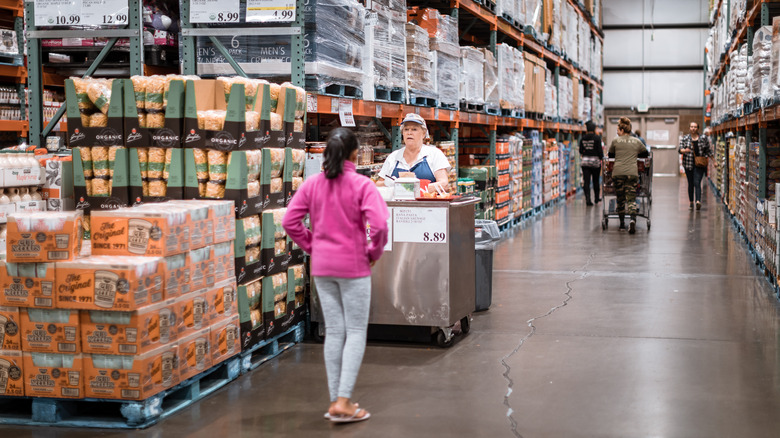How Costco's Entrance Is Secretly Designed To Loosen Your Wallet
There's no place like Costco. (Sorry, Sam's Club, but you just can't hold a candle to this wholesale juggernaut (even if the differences between you two are relatively minor).) Costco's membership model and bulk item deals have turned it into the world's second-largest retailer, only outdone by Walmart (via Statista).
Costco boasts 847 locations in 14 countries and a membership base of 120.9 million. These numbers reflect a business largely defined by bulk, from its wholesale products to the sheer vastness of its warehouses, averaging 146,000 square feet. For a first-timer, stepping into one of these stores gives one pause, as the mind struggles to wrap itself around a place where you can seemingly find everything.
And when we say everything, we mean everything. In 2019, Insider told the story of a couple in Hawaii who got married in the Costco aisle where they met, showing that cheap gas and rental cars are just the tip of the iceberg. You can even find love at Costco. That Insider story is just one of many glowing appraisals of the wholesale giant, which, by and large, receives great press. Forbes hailed the fact that Costco's famous hot dog and soda combo has retained its $1.50 price tag since the 1980s, making it one of the few products in this world unswayed by inflation. Costco has a reputation for being friendly to our wallets, but you might rethink that when you look behind the scenes.
Costco's layout promotes impulse buys
Despite the vastness of each location, Costco members can probably picture the whole store in their mind's eye without much effort. This is thanks to the warehouses' layouts, which Fast Company describes as "panoramic," offering customers a clear view of every section as soon as they enter the store. You instantly know where you need to go to get the items you need, but the pathway to each section is carefully planned to encourage higher spending. This is most obvious at the entrance to each warehouse, which inevitably features prominent displays of televisions, computers, and jewelry. Staple items such as food and toilet paper are placed at the back of the store, or the far ends of aisles, forcing you to pass more expensive items along the way.
This is all done to encourage impulse buys, which don't always align with Costco's discount reputation. Insider cautions customers against assuming that, just because Costco is a bargain store, it sells every item for less than its competitors. Some of those impulse buys aren't actually a good deal, but they're still hard to resist.
There are reasons behind this, according to Psychology Today, which notes that impulse buying is motivated by unconscious perceptions that bulk purchases represent better deals coupled with the fear of missing out on a good bargain. In fact, our very desire to save is rooted in the same survival instincts that lead animals to store food for the winter.
The layout isn't the only way Costco manipulates customers
There are other, subtler means by which Costco loosens our wallets. Fast Company notes that the stores routinely rearrange their shelves, rotating staple items known as "triggers." Triggers are often home goods, such as paper towels and detergent, which customers are most likely to need in bulk. By constantly moving trigger items to different shelves, Costco forces customers to take a different route to their staple goods each time they visit the store. This ensures that consumers invariably pass new items on their way to their regular purchases, piquing curiosity. Yahoo News also notes that Costco carries around 3,600 items but only displays about 1,000 of them at a time, making each deal seem fleeting, and playing into the fear of missing out.
Then there's the matter of free samples, one of Costco's most famous calling cards. You could get a pretty decent meal just by circling the warehouse and noshing on the freebies. Samples are a big part of Costco's reputation, something Insider says turns the store into a "destination," giving people a reason to go there beyond simply stocking their pantries. Those free morsels can trigger big cravings, getting us to purchase foods and beverages we never would have considered otherwise.
It's all very clever, but a key part of all these techniques is the idea that customers won't catch on to what Costco is doing. Now that you know, you've taken that advantage away.


